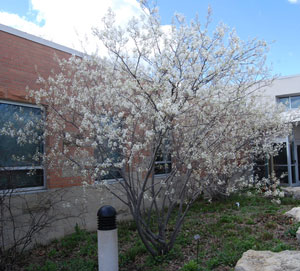
A Serviceberry in bloom at the Discovery Center at 47th and Troost. Our guest poster suggests they are a great native alternative to the ornamental pear trees so popular in Midtown. Photo by Kate Corwin.
Guest post by Kate Corwin, Southmoreland neighborhood
I was in Weston Missouri a few weekends ago and noticed the stunning white blooms of ornamental pear trees along the bluffs. The problem is they shouldn’t be there. These trees are an Asian import that is extremely popular because of those stunning white flowers, and no messy fruit. It was originally thought that these trees were unable to reproduce, but in the late 1990s the trees began spreading into our fields and open areas where they are crowding out native species.
In our area the most common ornamental pears are Bradfords, but there are a number of Callery pear cultivars including Aristocrat, Redspire and Chanticleer. They line Broadway and Westport Road and are a favorite landscape tree in Midtown yards. Several years ago the city removed all Callery pear trees from the list of acceptable street trees. Unfortunately, property owners are still planting them.
With the recent drought, we have a perfect opportunity to start replacing pear trees (and other non-natives) with native varieties. Native trees have a number of advantages. They are often hardier and stronger (less breakage from snow and ice), and they help feed our bees, butterflies, insects and birds. (And if you want birds in your yard, you have to feed the insects that feed the birds!) One of the best alternatives to ornamental pear trees is a native Downy Serviceberry. Serviceberries bear white flowers in the spring, purple berries for the birds (or people) in the summer and glorious fall foliage.
The Missouri Department of Conservation also recommends our state tree, the flowering dogwood. Just be sure to plant a native variety of Flowering Dogwood or Pagoda Dogwood (Cornus florida or Cornus alternifolia). Redbuds are another good small tree choice. For larger trees, MDC suggests red or white oaks and red or sugar maples. When possible, buy from locally owned nurseries that grow trees in Missouri. Native trees are a little more difficult to find at nurseries than the exotic pears, but well worth the trouble. Natives are adapted to our climate and soils, are less prone to weather damage and don’t carry the ecological problems of imports.
It’s not always easy to figure out how one person can make an impact on the environment. But in the case of ornamental pear trees, we can each make a significant impact by replacing them with native trees.
(Guest poster Kate Corwin’s book on native plants, “A Little Bit of Wild – The Best Native Plants to Bring your Garden to Life” is on sale at Nature’s Own at 43rd and Main in Midtown. Corwin is the president and founder of GreenWorks, a nonprofit engaging urban youth in sustainable environmental stewardship and the green economy. All proceeds from the book support Green Works’ programming in urban neighborhoods.)
More information
- Urban trees for Missouri
- Heartland Tree Alliance
- How native plants and trees help wildlife
- Columbia MO, Stop the Spread campaign



Who’s talking